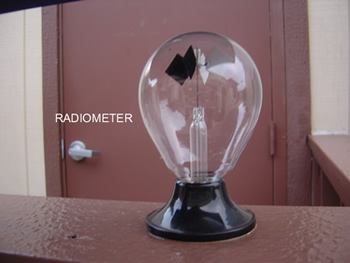Radiometer
SED 695B; Fall 2005
Principles illustrated:•
To observe the movement of the vanes in a radiometer due molecular movement caused by different light types.

Standards addressed:
Physics:
4. Waves have characteristic properties that do not depend on the type of wave.
As a basis for understanding this concept:
a. Students know waves carry energy from one place to another.
Materials:
-
Radiometer
-
Sunny Day
-
Fluorescent Light
-
Incandescent Light
-
UV Light
Procedure:
1. Place radiometer in full
sunlight, make sure that there is no cloud cover, or that it is minimal.
2. Make some observations about the rotation of vanes while it is outside.
Talk about the speed of the vanes
3. Place the radiometer under a fluorescent lamp in the lab. Make sure
to turn off the overhead lights in the classroom. Observe
rotation of vanes and make
some observations
about the speed of the vanes.
4. Place radiometer under an ultraviolet lamp in the lab. Make sure to
turn off the overhead lights in the classroom. Make some observations
about the speed of rotation of the vanes.
5. Place the radiometer under an incandescent light source. Make some observations about the speed of the vanes in the radiometer.


References & Links:
History of the Crookes radiometer
http://www.belljar.net/radio.htm
Simple explanation of a radiometer
http://www.newton.dep.anl.gov/askasci/phy99/phy99182.htm